Figure Design
remixed from Claus O. Wilke’s SDS375 course
How to go from this …
… to this?


Requires coordinated modification of multiple elements:
- geoms (via arguments to geoms)
- scales (via scale_*() functions)
- plot appearance (via themes)
The starting point, a rough draft
ggplot(lincoln_temps) +
aes(x = mean_temp, y = month_long) +
geom_density_ridges()
lincoln_temps <- readRDS(
url("https://wilkelab.org/DSC385/datasets/lincoln_temps.rds")
)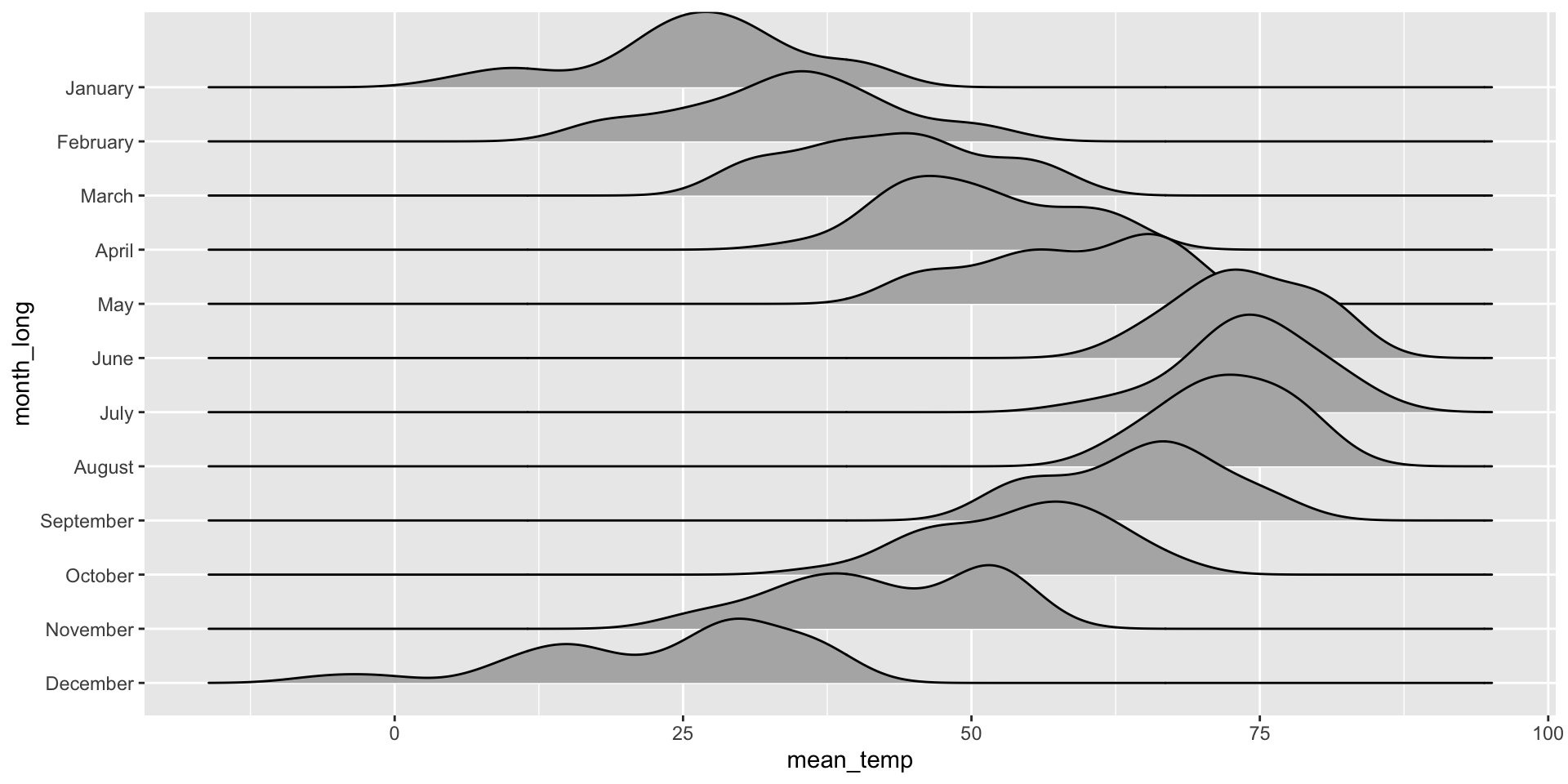
You can download the dataset using this code:
Set scale and bandwidth to shape ridgelines
ggplot(lincoln_temps) +
aes(x = mean_temp, y = month_long) +
geom_density_ridges(
scale = 3, bandwidth = 3.4
)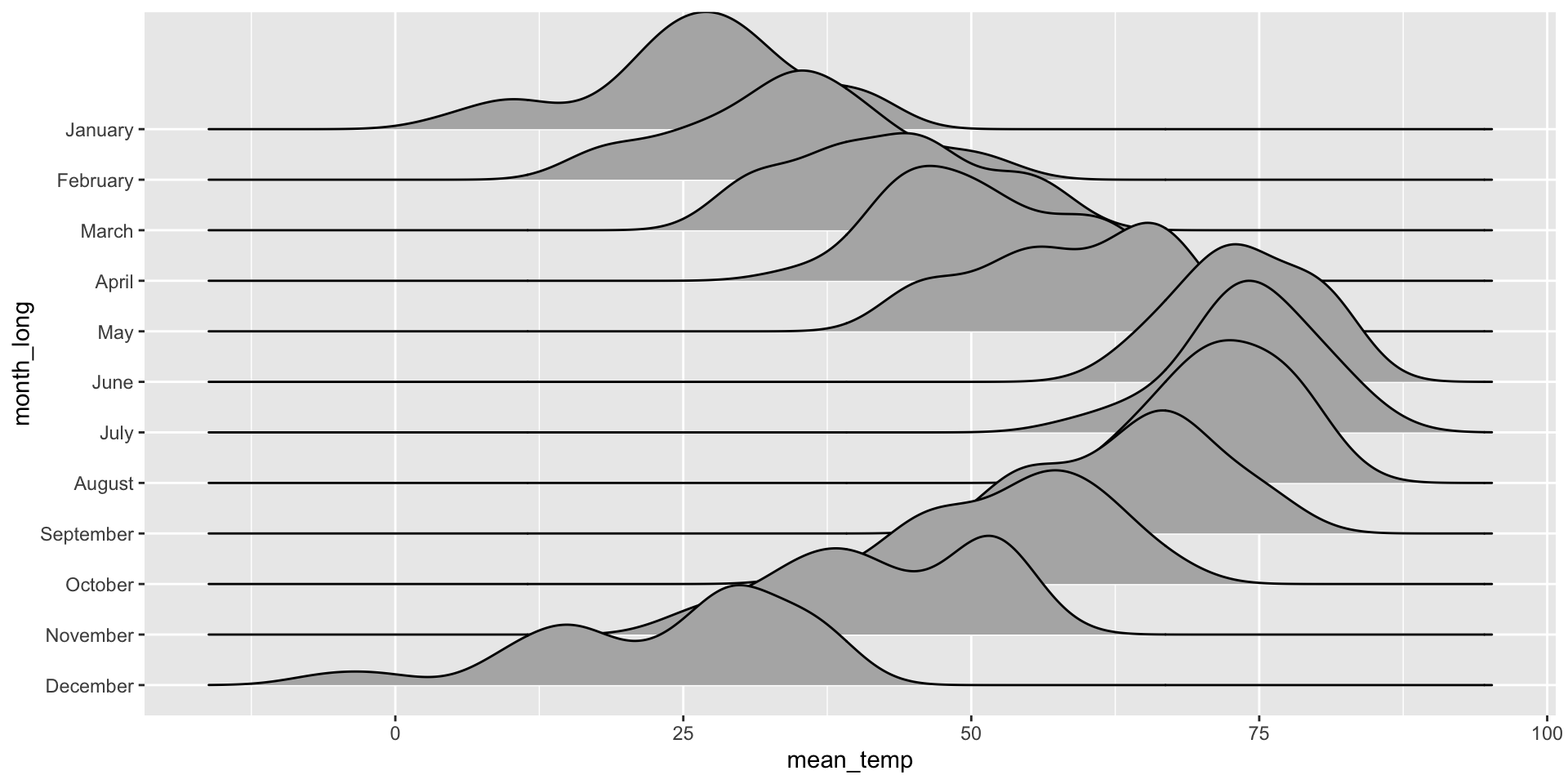
Set rel_min_height to cut ridgelines near zero
ggplot(lincoln_temps) +
aes(x = mean_temp, y = month_long) +
geom_density_ridges(
scale = 3, bandwidth = 3.4,
rel_min_height = 0.01
)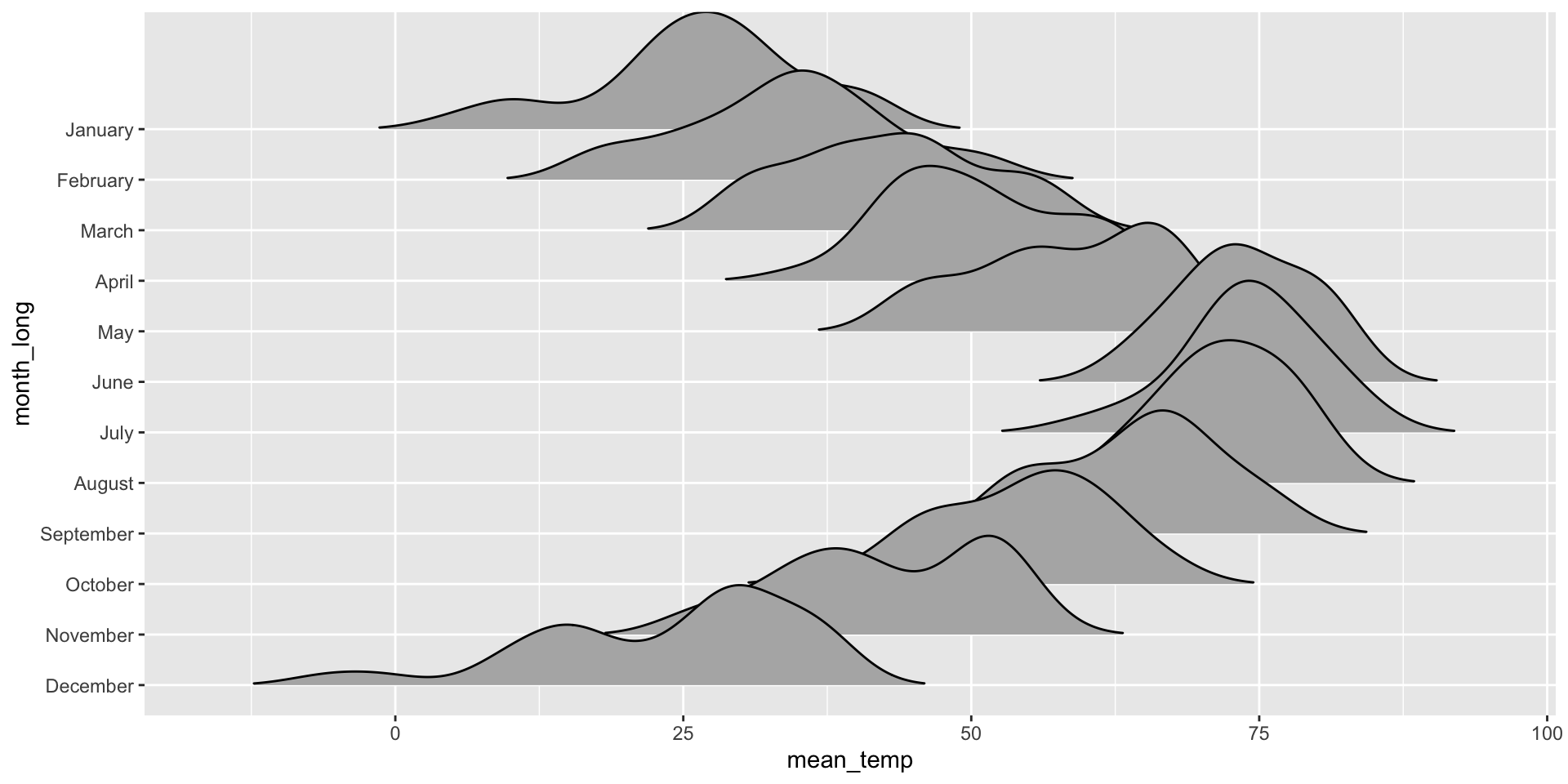
Use scale_*() functions to specify axis labels
ggplot(lincoln_temps) +
aes(x = mean_temp, y = month_long) +
geom_density_ridges(
scale = 3, bandwidth = 3.4,
rel_min_height = 0.01,
) +
scale_x_continuous(
name = "mean temperature (°F)"
) +
scale_y_discrete(
name = NULL # NULL means no label
)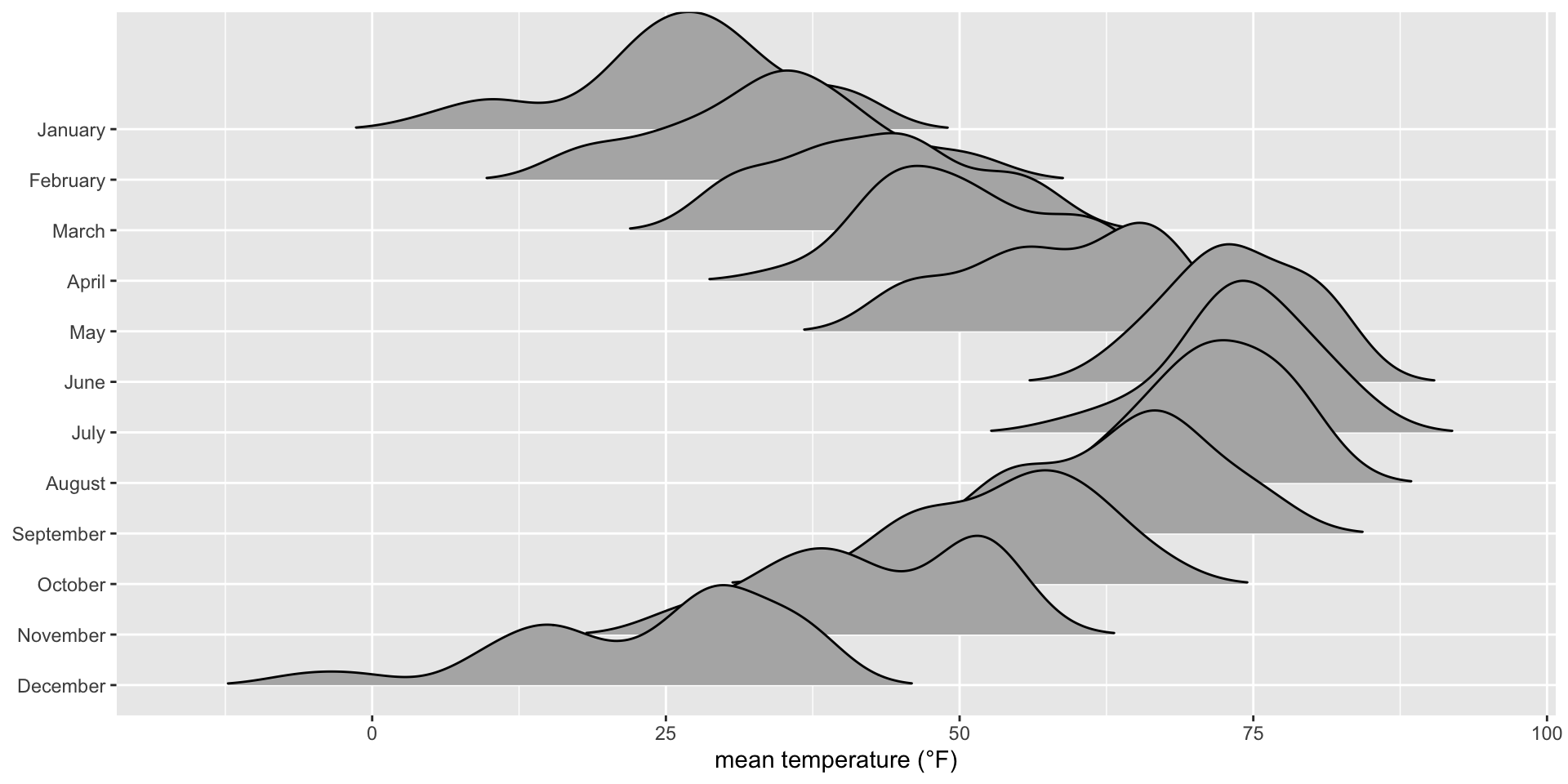
Specify scale expansion
ggplot(lincoln_temps) +
aes(x = mean_temp, y = month_long) +
geom_density_ridges(
scale = 3, bandwidth = 3.4,
rel_min_height = 0.01
) +
scale_x_continuous(
name = "mean temperature (°F)",
expand = c(0, 0)
) +
scale_y_discrete(
name = NULL,
expand = expansion(add = c(0.2, 2.6))
)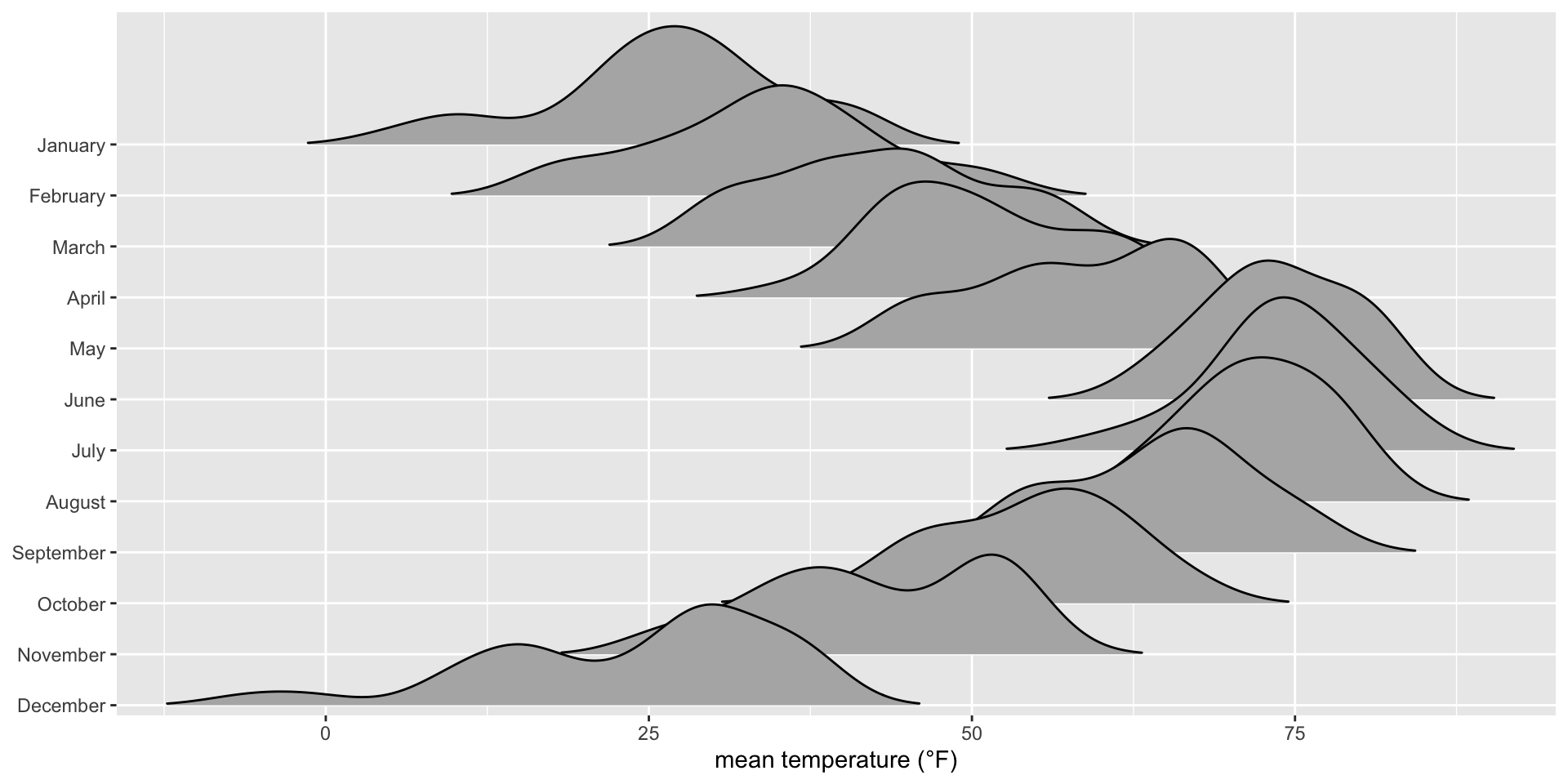
Set overall plot theme
ggplot(lincoln_temps) +
aes(x = mean_temp, y = month_long) +
geom_density_ridges(
scale = 3, bandwidth = 3.4,
rel_min_height = 0.01
) +
scale_x_continuous(
name = "mean temperature (°F)",
expand = c(0, 0)
) +
scale_y_discrete(
name = NULL,
expand = expansion(add = c(0.2, 2.6))
) +
theme_minimal_grid() # from cowplot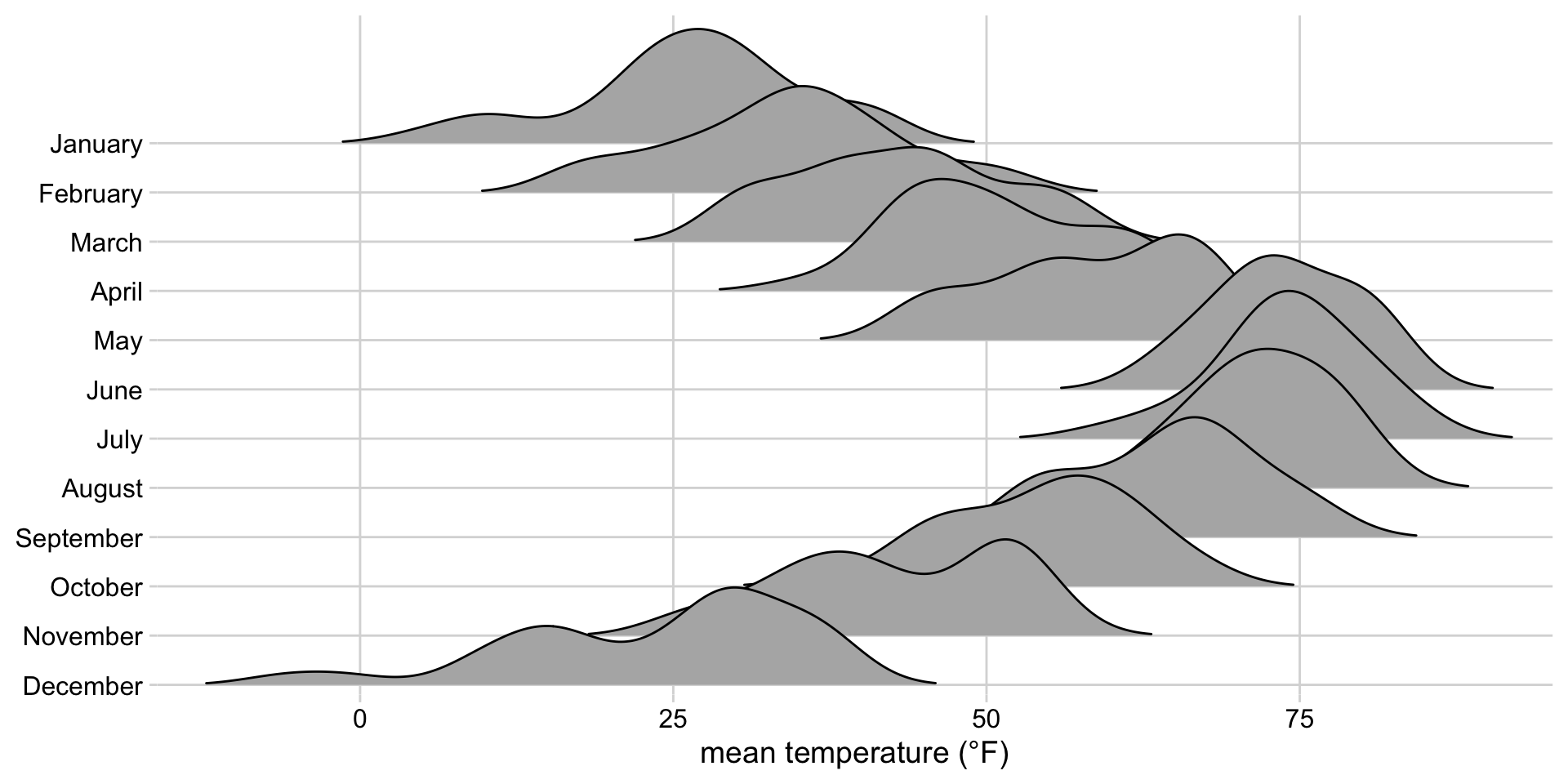
Align y axis labels to grid lines
ggplot(lincoln_temps) +
aes(x = mean_temp, y = month_long) +
geom_density_ridges(
scale = 3, bandwidth = 3.4,
rel_min_height = 0.01
) +
scale_x_continuous(
name = "mean temperature (°F)",
expand = c(0, 0)
) +
scale_y_discrete(
name = NULL,
expand = expansion(add = c(0.2, 2.6))
) +
theme_minimal_grid() +
theme(
axis.text.y = element_text(vjust = 0)
)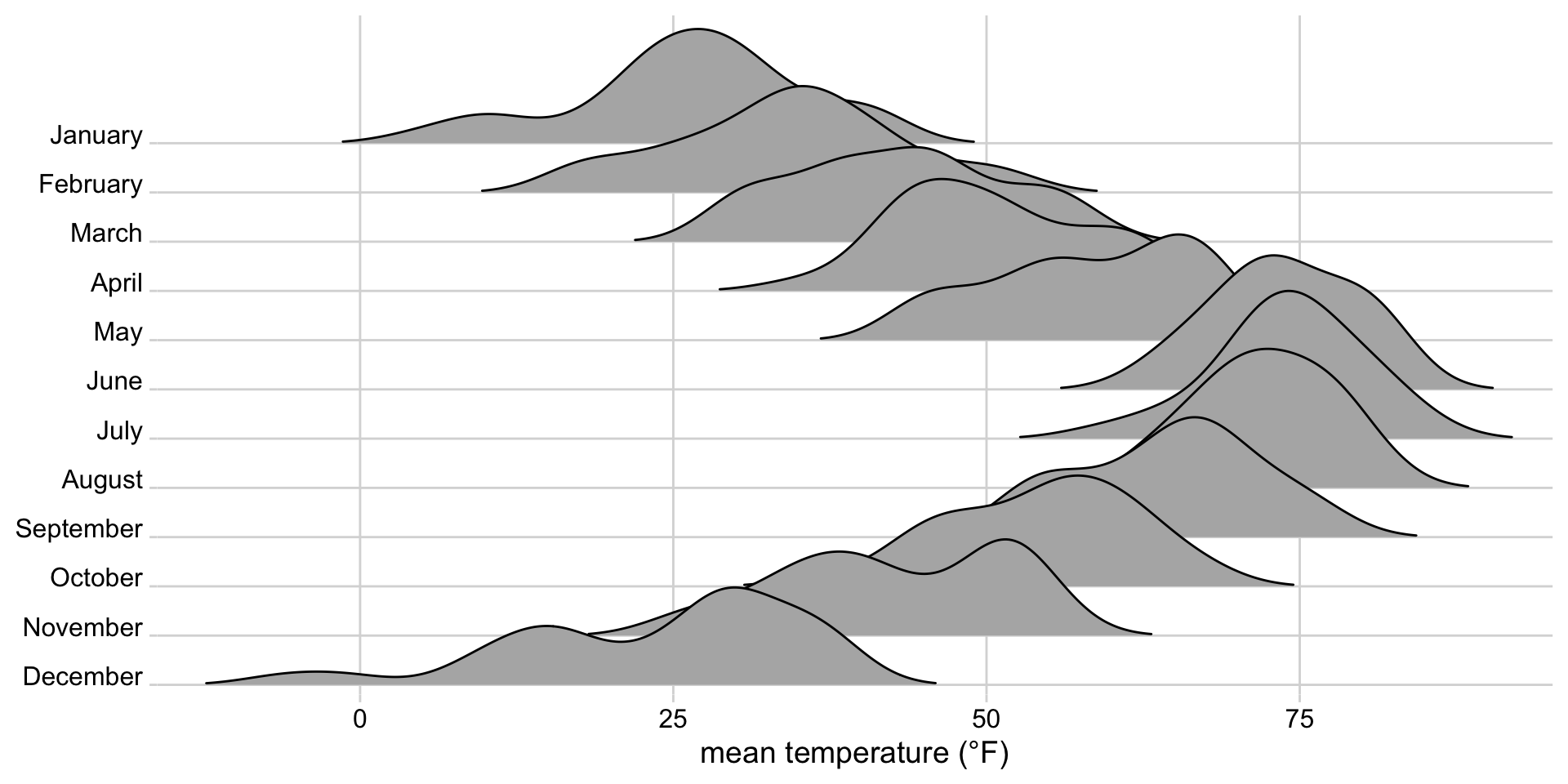
Change fill color from default gray to blue
ggplot(lincoln_temps) +
aes(x = mean_temp, y = month_long) +
geom_density_ridges(
scale = 3, bandwidth = 3.4,
rel_min_height = 0.01,
fill = "#7DCCFF"
) +
scale_x_continuous(
name = "mean temperature (°F)",
expand = c(0, 0)
) +
scale_y_discrete(
name = NULL,
expand = expansion(add = c(0.2, 2.6))
) +
theme_minimal_grid() +
theme(
axis.text.y = element_text(vjust = 0)
)
Draw lines in white instead of black
ggplot(lincoln_temps) +
aes(x = mean_temp, y = month_long) +
geom_density_ridges(
scale = 3, bandwidth = 3.4,
rel_min_height = 0.01,
fill = "#7DCCFF",
color = "white"
) +
scale_x_continuous(
name = "mean temperature (°F)",
expand = c(0, 0)
) +
scale_y_discrete(
name = NULL,
expand = expansion(add = c(0.2, 2.6))
) +
theme_minimal_grid() +
theme(
axis.text.y = element_text(vjust = 0)
)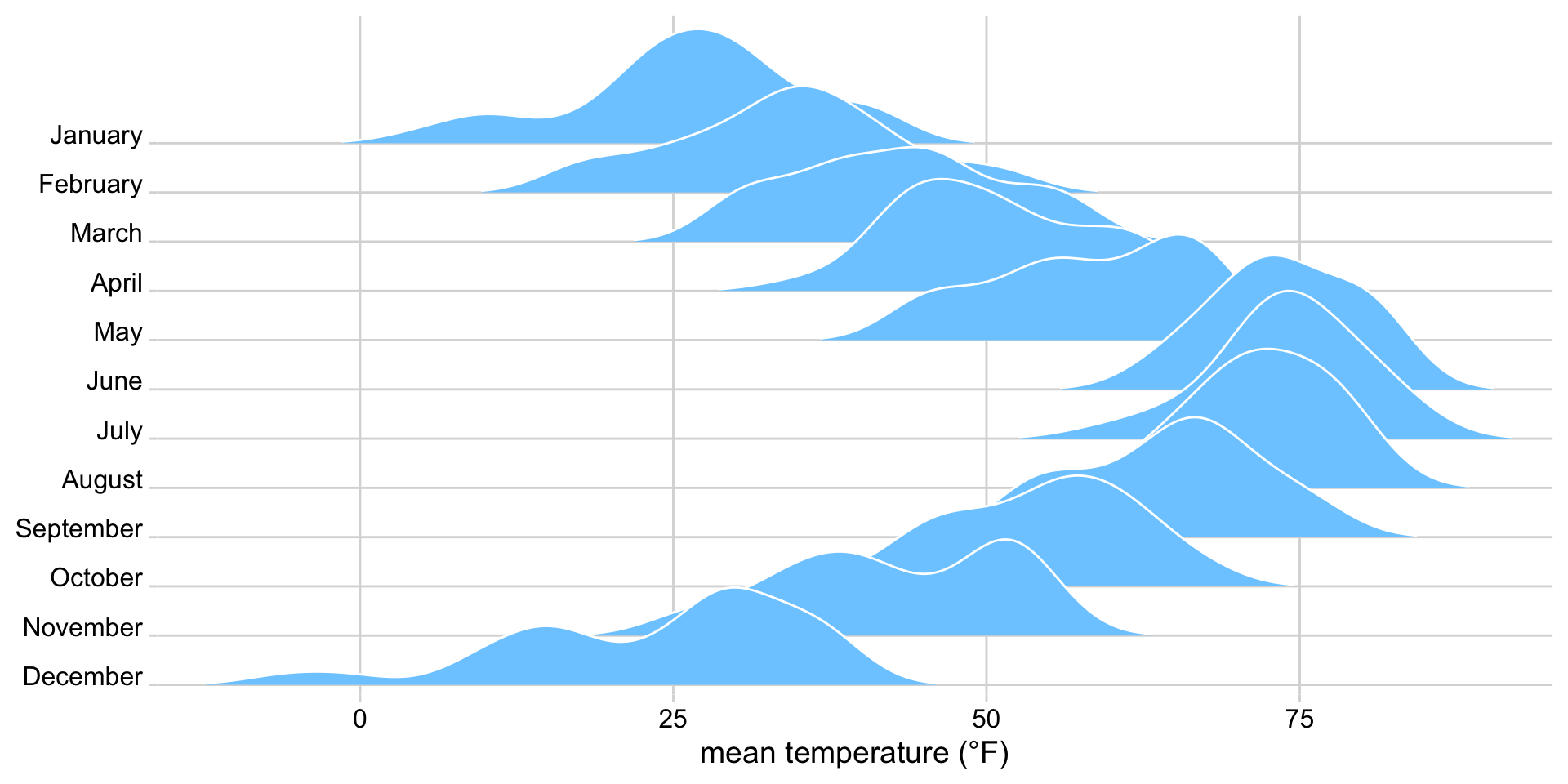
Working with ggplot themes
Using ready-made themes
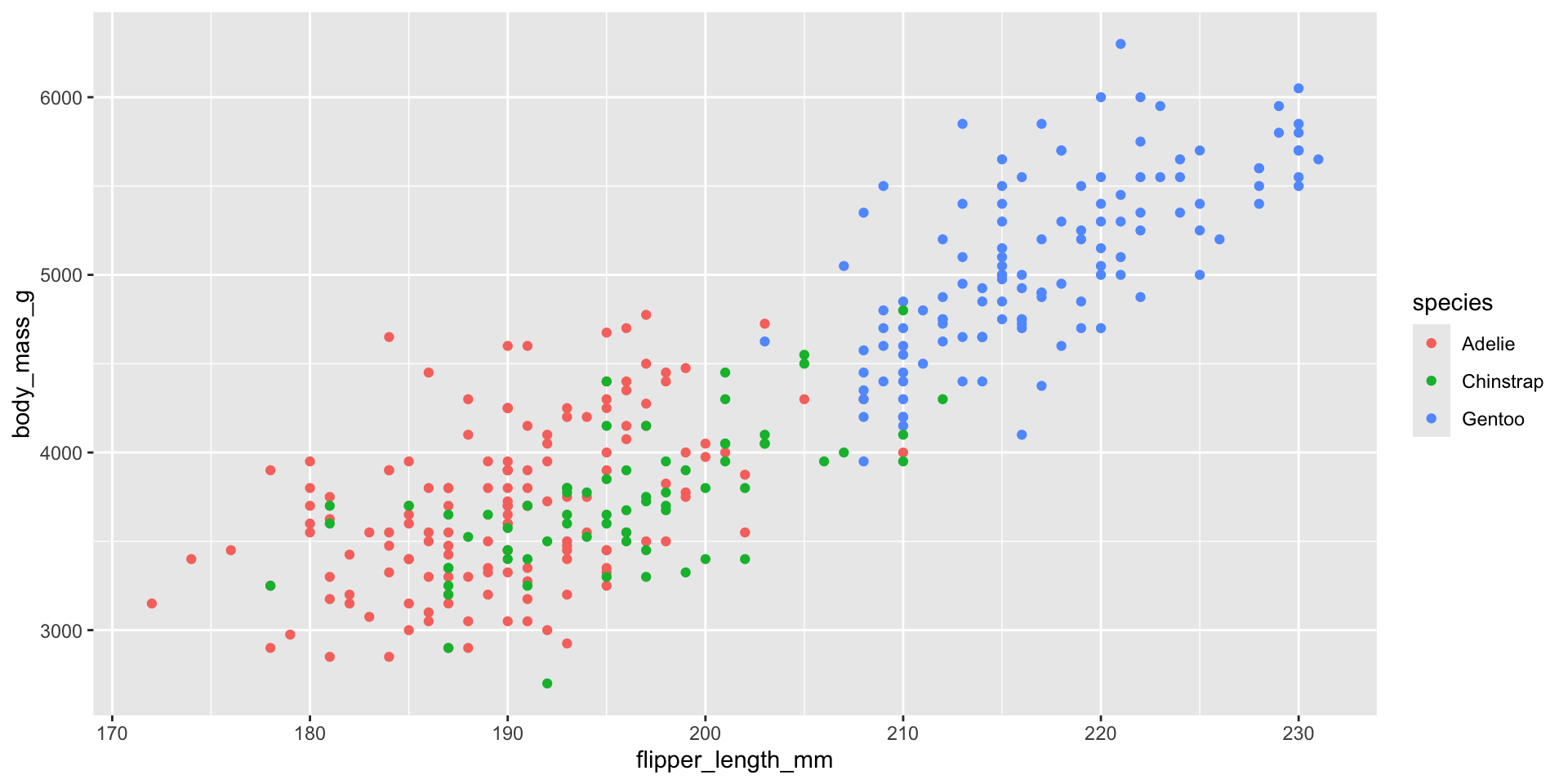
Using ready-made themes
Using ready-made themes
Using ready-made themes
Using ready-made themes
Using ready-made themes
Using ready-made themes
Using ready-made themes
Using ready-made themes
Using ready-made themes
Using ready-made themes
Using ready-made themes
Using ready-made themes
Customizing theme elements
ggplot(penguins) +
aes(flipper_length_mm, body_mass_g) +
geom_point(aes(color = species)) +
theme_minimal_grid()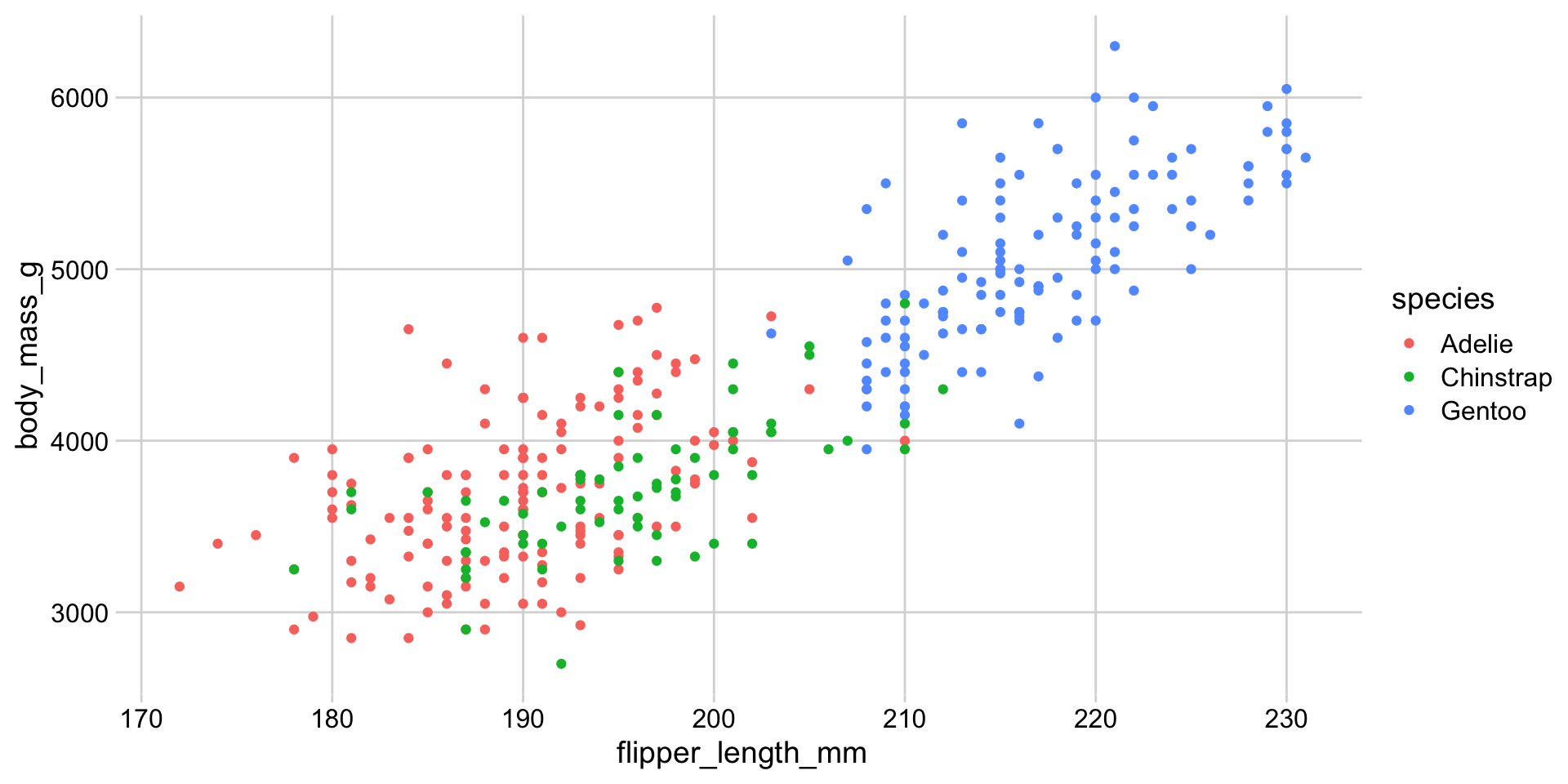
Customizing theme elements
ggplot(penguins) +
aes(flipper_length_mm, body_mass_g) +
geom_point(aes(color = species)) +
theme_minimal_grid() +
theme(
# change overall font family
# (requires font to be available)
text = element_text(
family = "Comic Sans MS"
)
)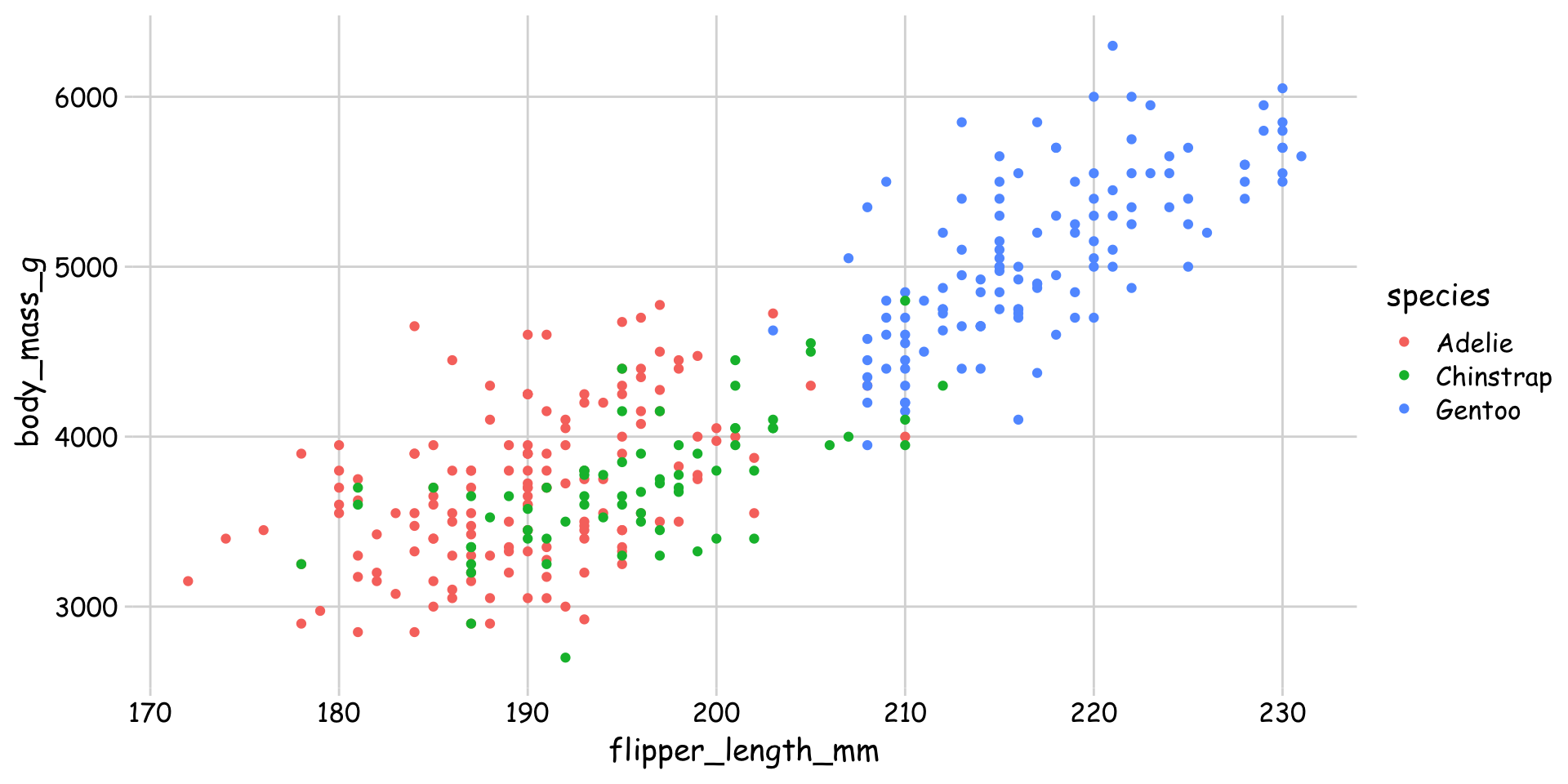
Customizing theme elements
ggplot(penguins) +
aes(flipper_length_mm, body_mass_g) +
geom_point(aes(color = species)) +
theme_minimal_grid() +
theme(
# change color of axis titles
axis.title = element_text(
color = "royalblue2"
)
)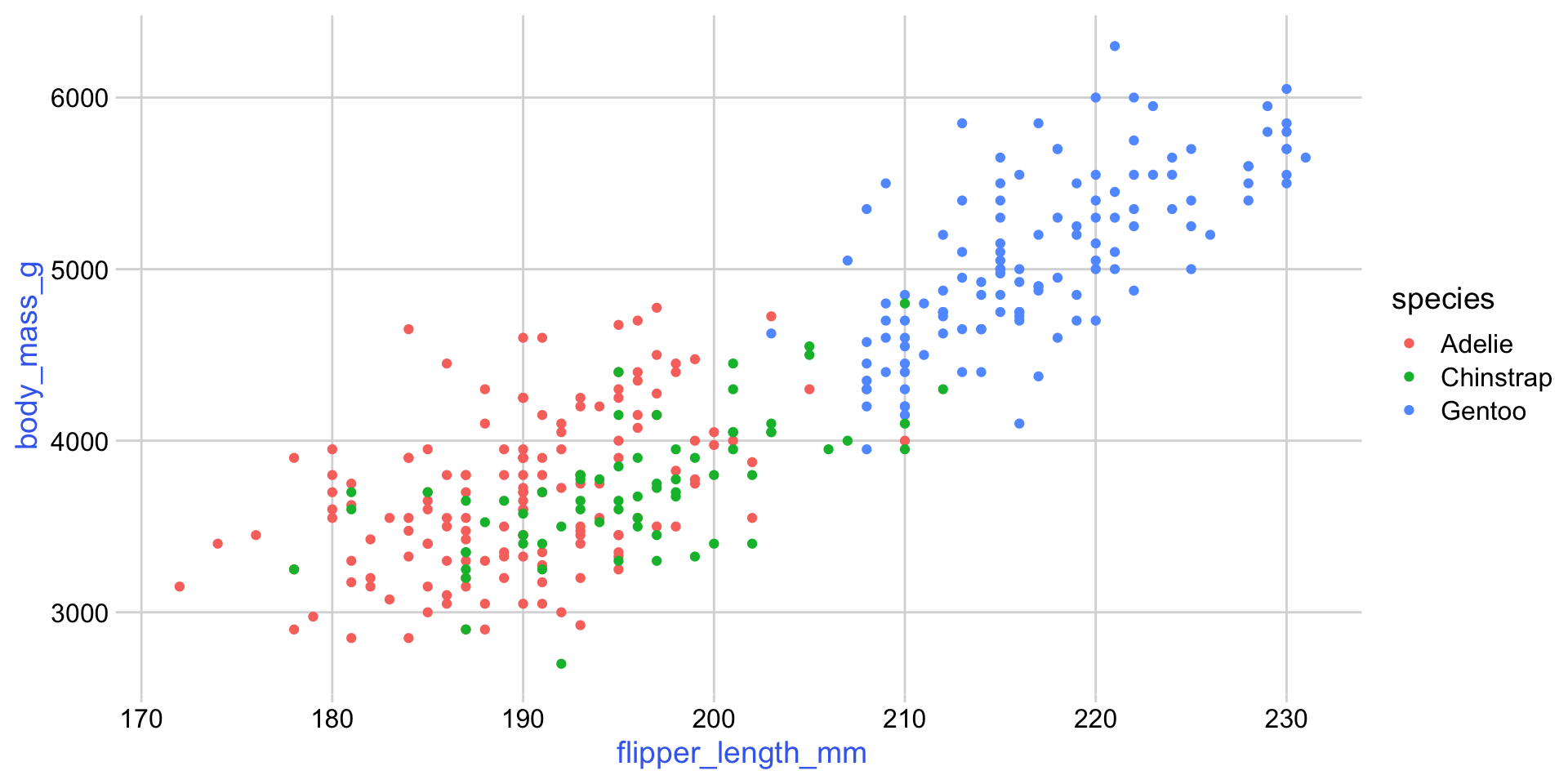
Customizing theme elements
ggplot(penguins) +
aes(flipper_length_mm, body_mass_g) +
geom_point(aes(color = species)) +
theme_minimal_grid() +
theme(
# change color of only the x axis title
axis.title.x = element_text(
color = "royalblue2"
)
)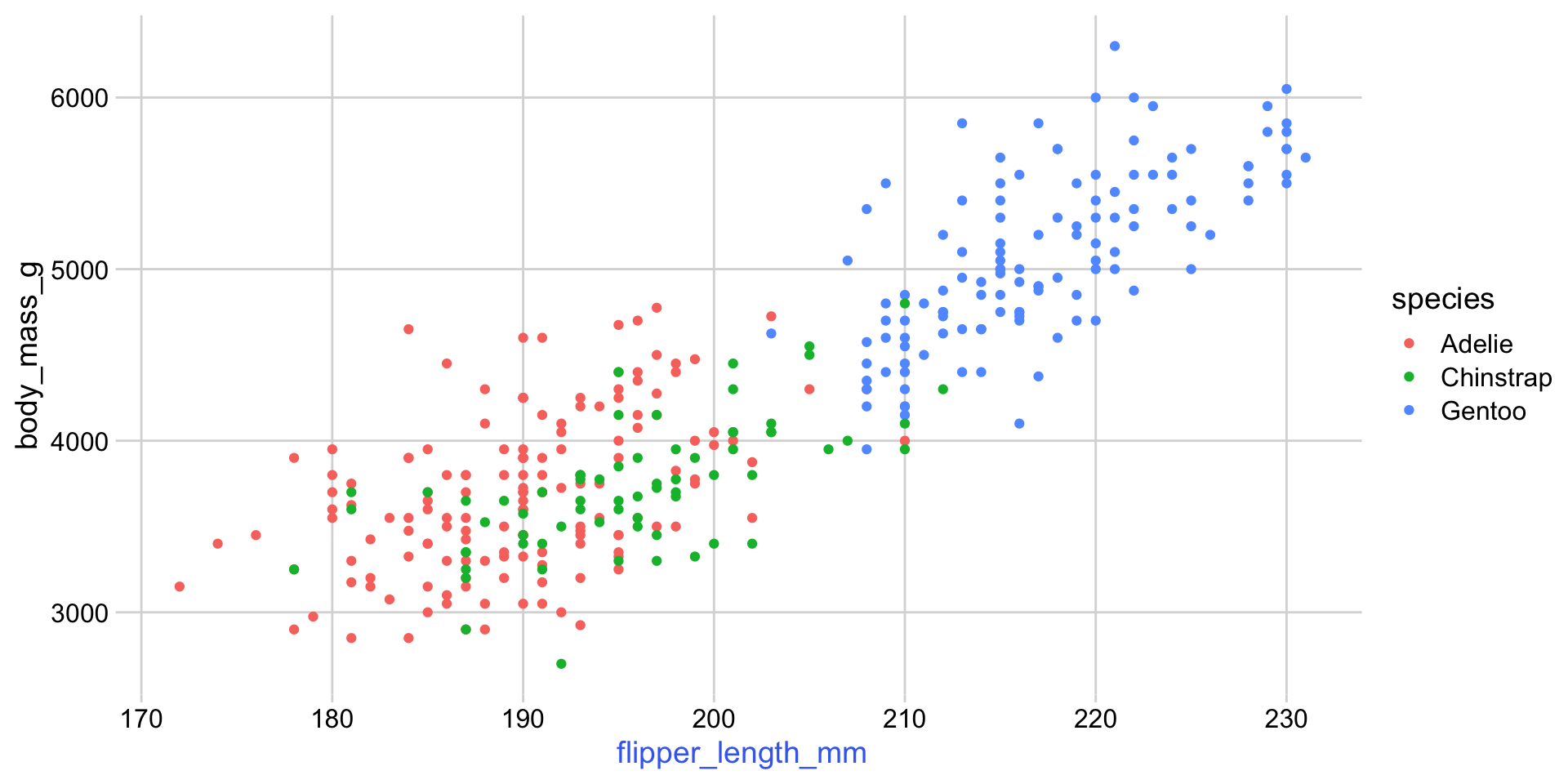
Customizing theme elements
ggplot(penguins) +
aes(flipper_length_mm, body_mass_g) +
geom_point(aes(color = species)) +
theme_minimal_grid() +
theme(
# change all text colors?
# why does it not work?
text = element_text(color = "royalblue2")
)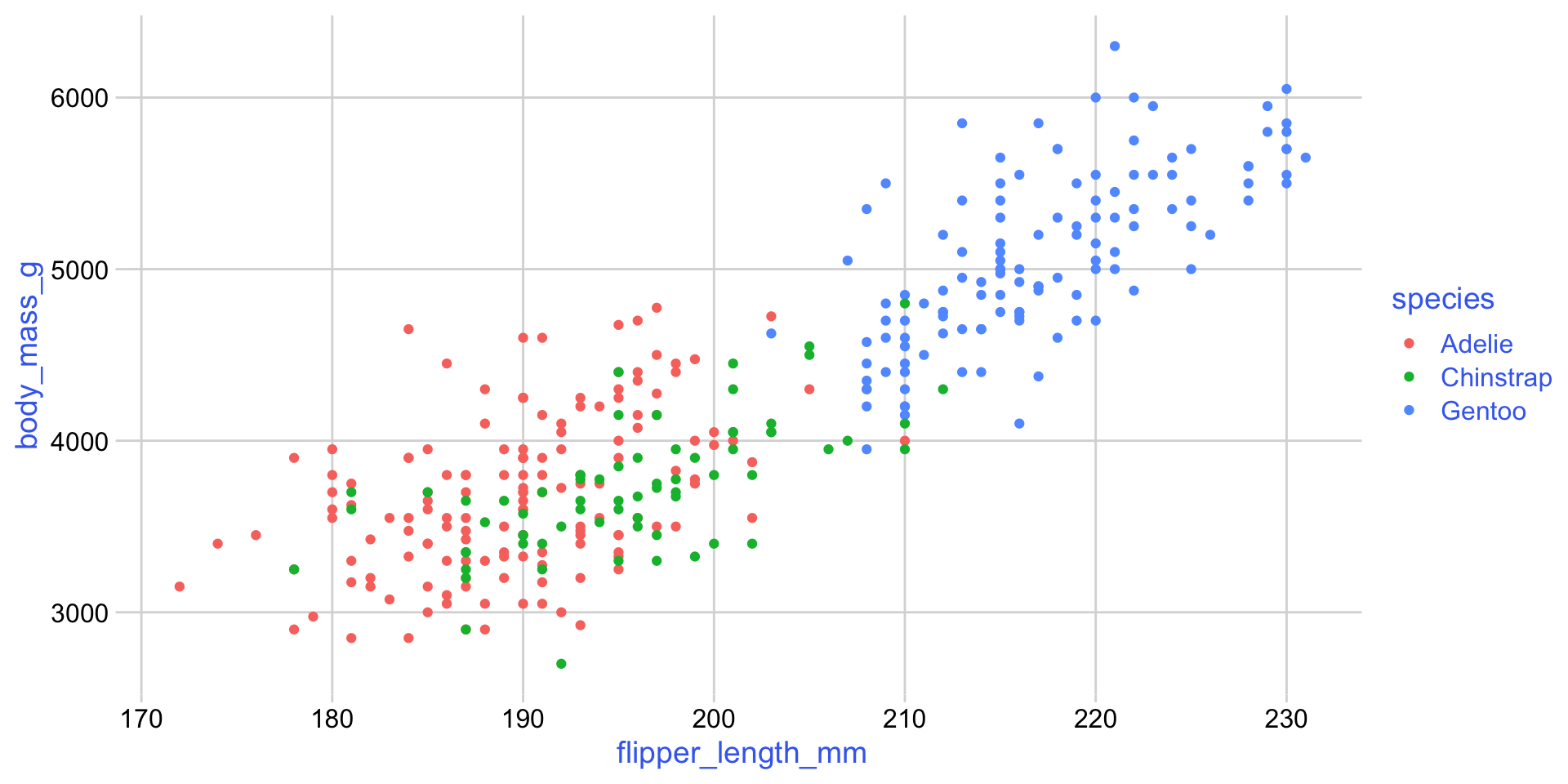
Customizing theme elements
ggplot(penguins) +
aes(flipper_length_mm, body_mass_g) +
geom_point(aes(color = species)) +
theme_minimal_grid() +
theme(
text = element_text(color = "royalblue2"),
axis.text = element_text(
color = "royalblue2"
)
)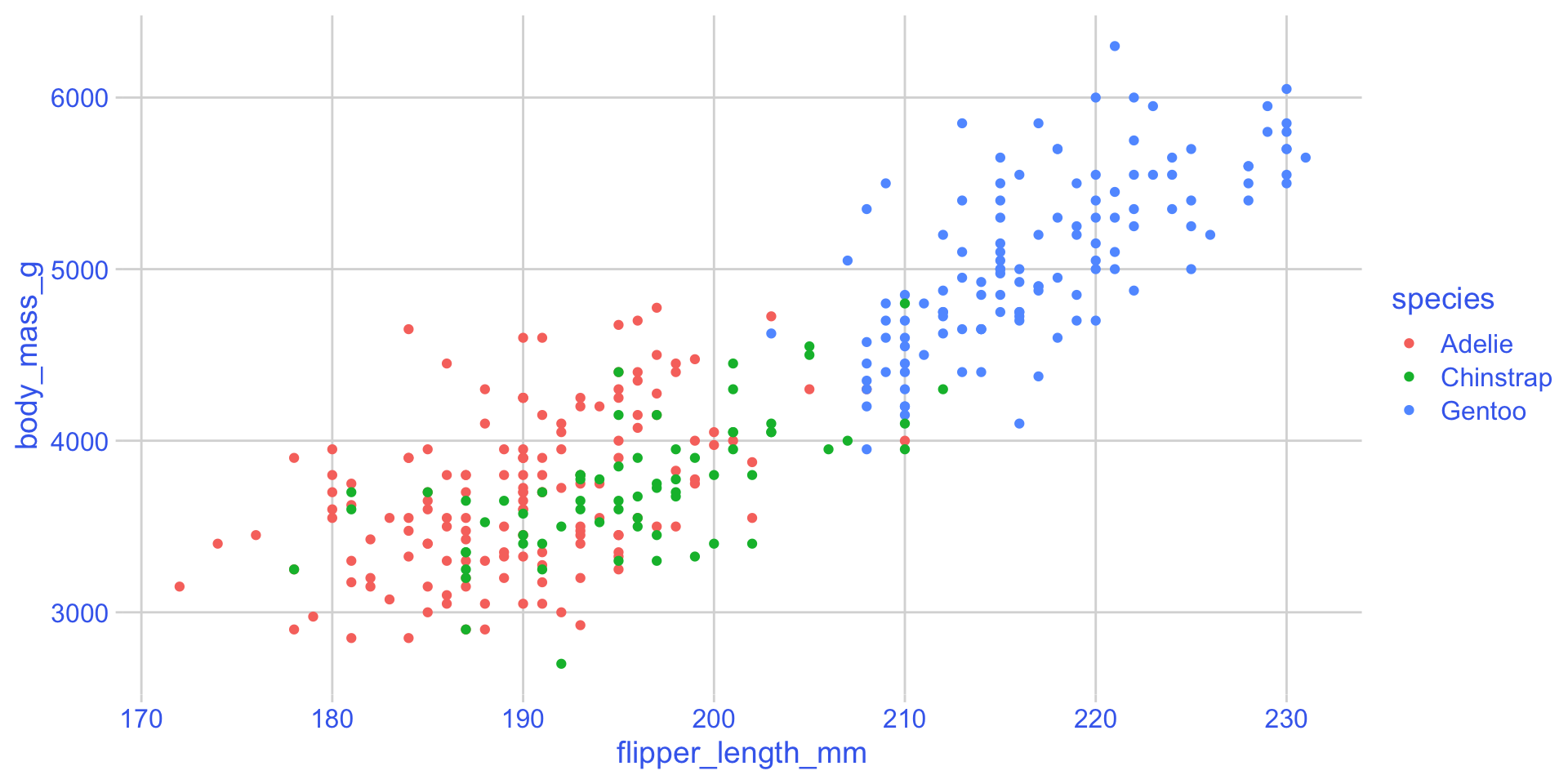
Customizing theme elements
ggplot(penguins) +
aes(flipper_length_mm, body_mass_g) +
geom_point(aes(color = species)) +
theme_minimal_grid() +
theme(
text = element_text(color = "royalblue2"),
axis.text = element_text(
color = "royalblue2"
)
)
The element axis.text has its own color set in the theme. Therefore it doesn’t inherit from text.
Horizontal and vertical alignment
ggplot(penguins) +
aes(flipper_length_mm, body_mass_g) +
geom_point(aes(color = species)) +
theme_minimal_grid() +
theme(
axis.title.x = element_text(
# horizontal justification
# (0 = left)
hjust = 0
)
)
Horizontal and vertical alignment
ggplot(penguins) +
aes(flipper_length_mm, body_mass_g) +
geom_point(aes(color = species)) +
theme_minimal_grid() +
theme(
axis.title.x = element_text(
# horizontal justification
# (0.5 = center)
hjust = 0.5
)
)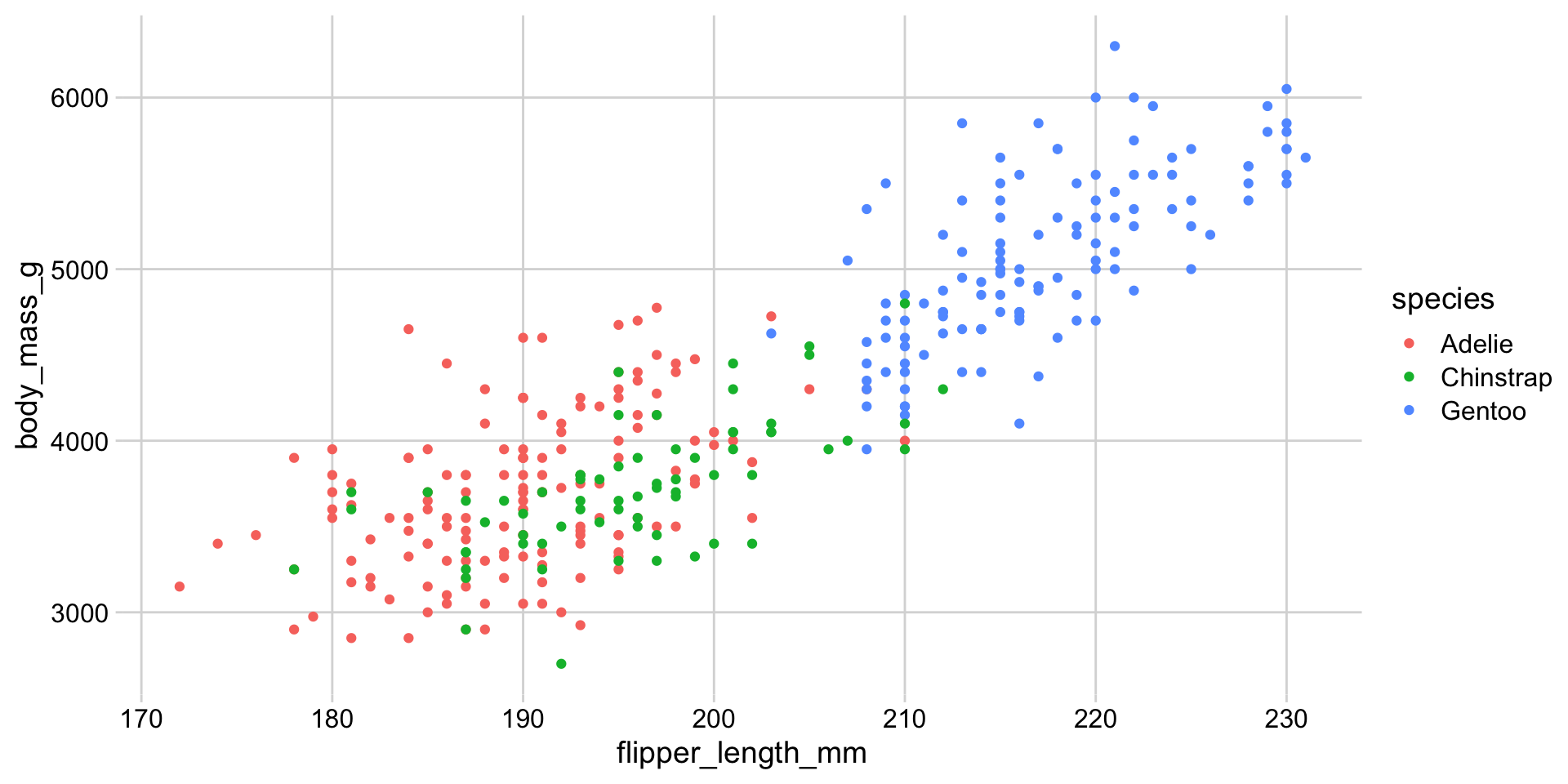
Horizontal and vertical alignment
ggplot(penguins) +
aes(flipper_length_mm, body_mass_g) +
geom_point(aes(color = species)) +
theme_minimal_grid() +
theme(
axis.title.x = element_text(
# horizontal justification
# (1 = right)
hjust = 1
)
)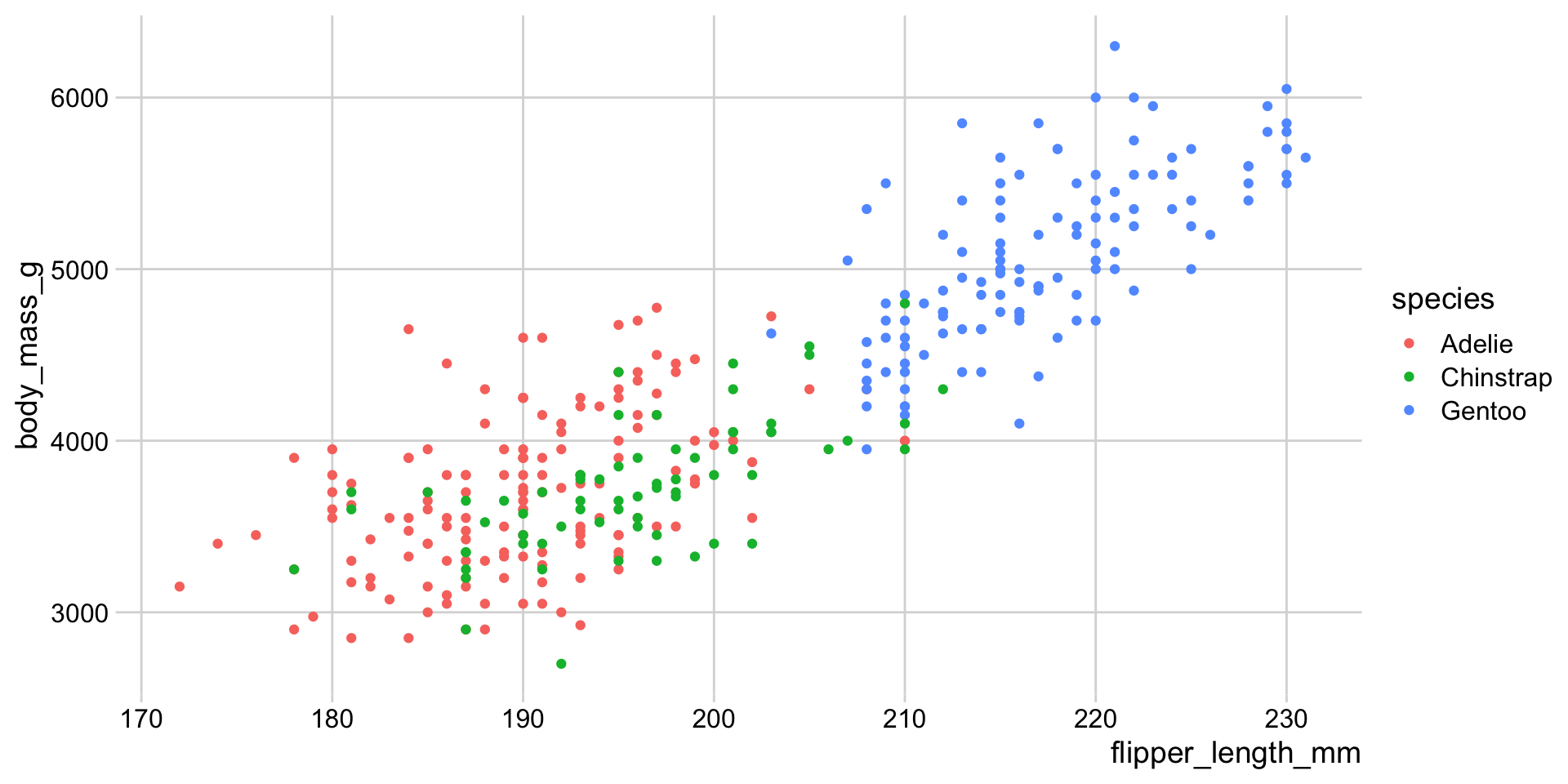
Horizontal and vertical alignment
ggplot(penguins) +
aes(flipper_length_mm, body_mass_g) +
geom_point(aes(color = species)) +
theme_minimal_grid() +
theme(
axis.text.y = element_text(
# vertical justification
# (0 = bottom)
vjust = 0
)
)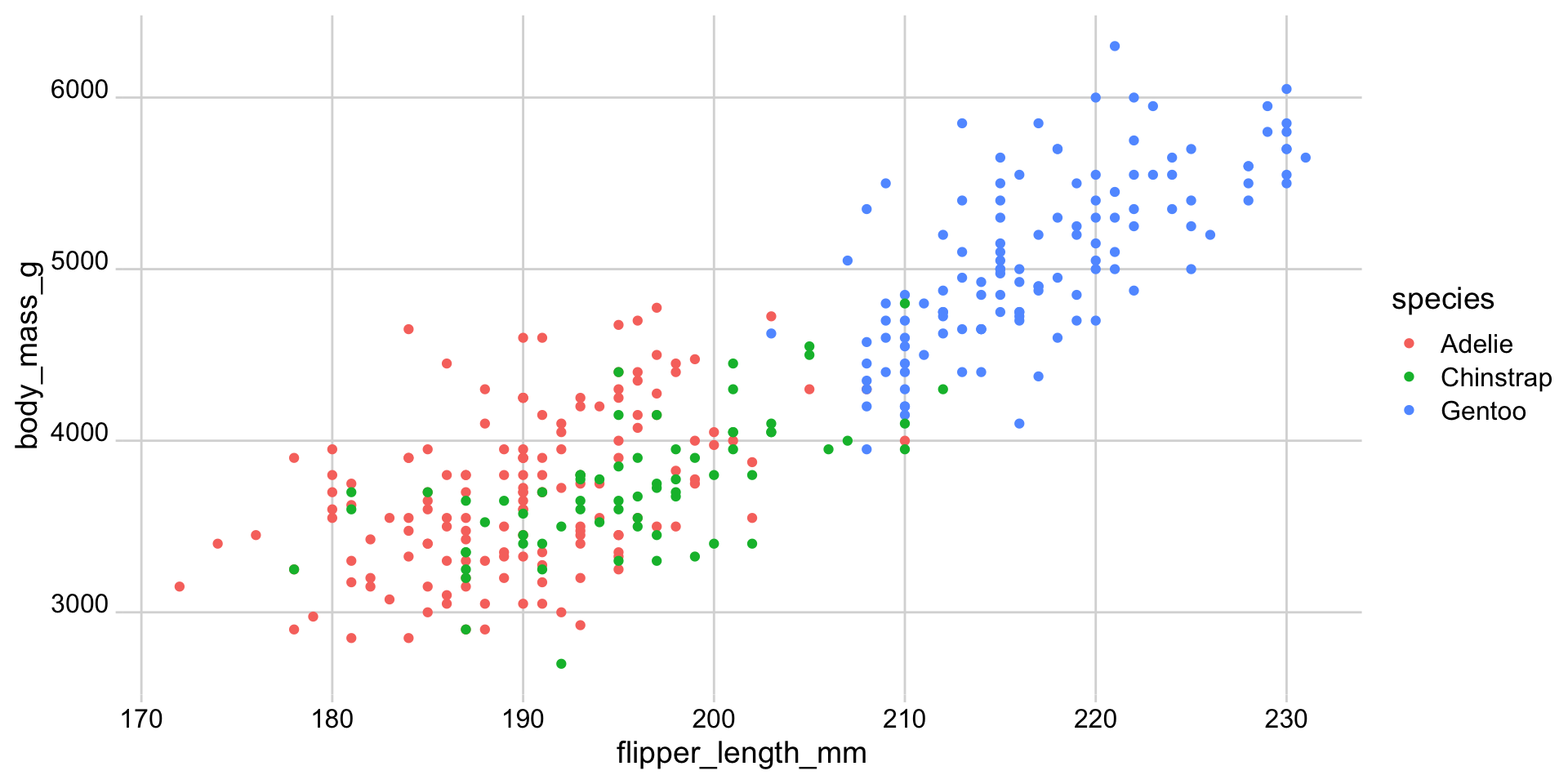
Horizontal and vertical alignment
ggplot(penguins) +
aes(flipper_length_mm, body_mass_g) +
geom_point(aes(color = species)) +
theme_minimal_grid() +
theme(
axis.text.y = element_text(
# vertical justification
# (0.5 = center)
vjust = 0.5
)
)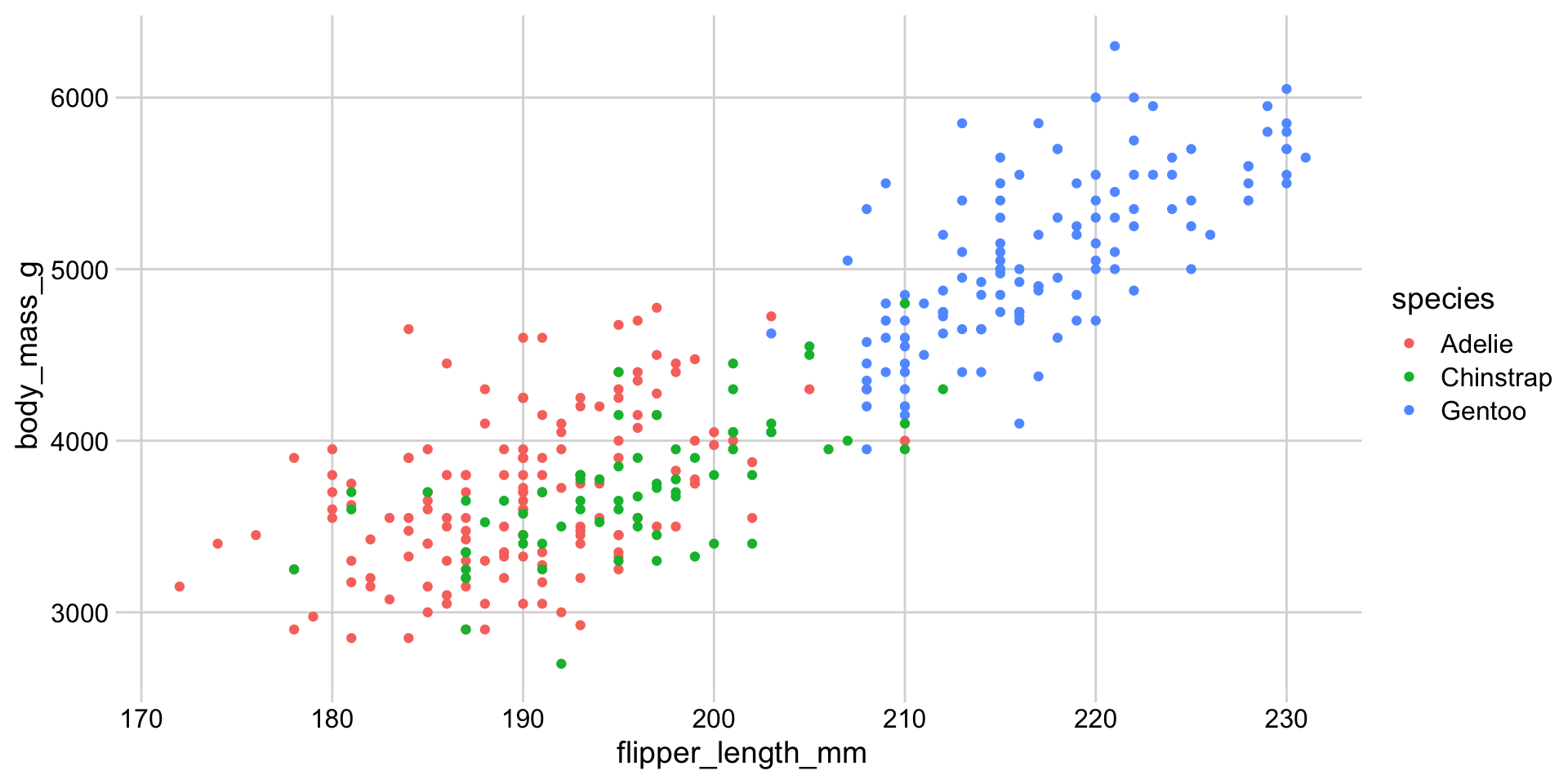
Horizontal and vertical alignment
ggplot(penguins) +
aes(flipper_length_mm, body_mass_g) +
geom_point(aes(color = species)) +
theme_minimal_grid() +
theme(
axis.text.y = element_text(
# vertical justification
# (1 = top)
vjust = 1
)
)
Remove elements entirely: element_blank()
ggplot(penguins) +
aes(flipper_length_mm, body_mass_g) +
geom_point(aes(color = species)) +
theme_minimal_grid() +
theme(
# all text gone
axis.text = element_blank()
)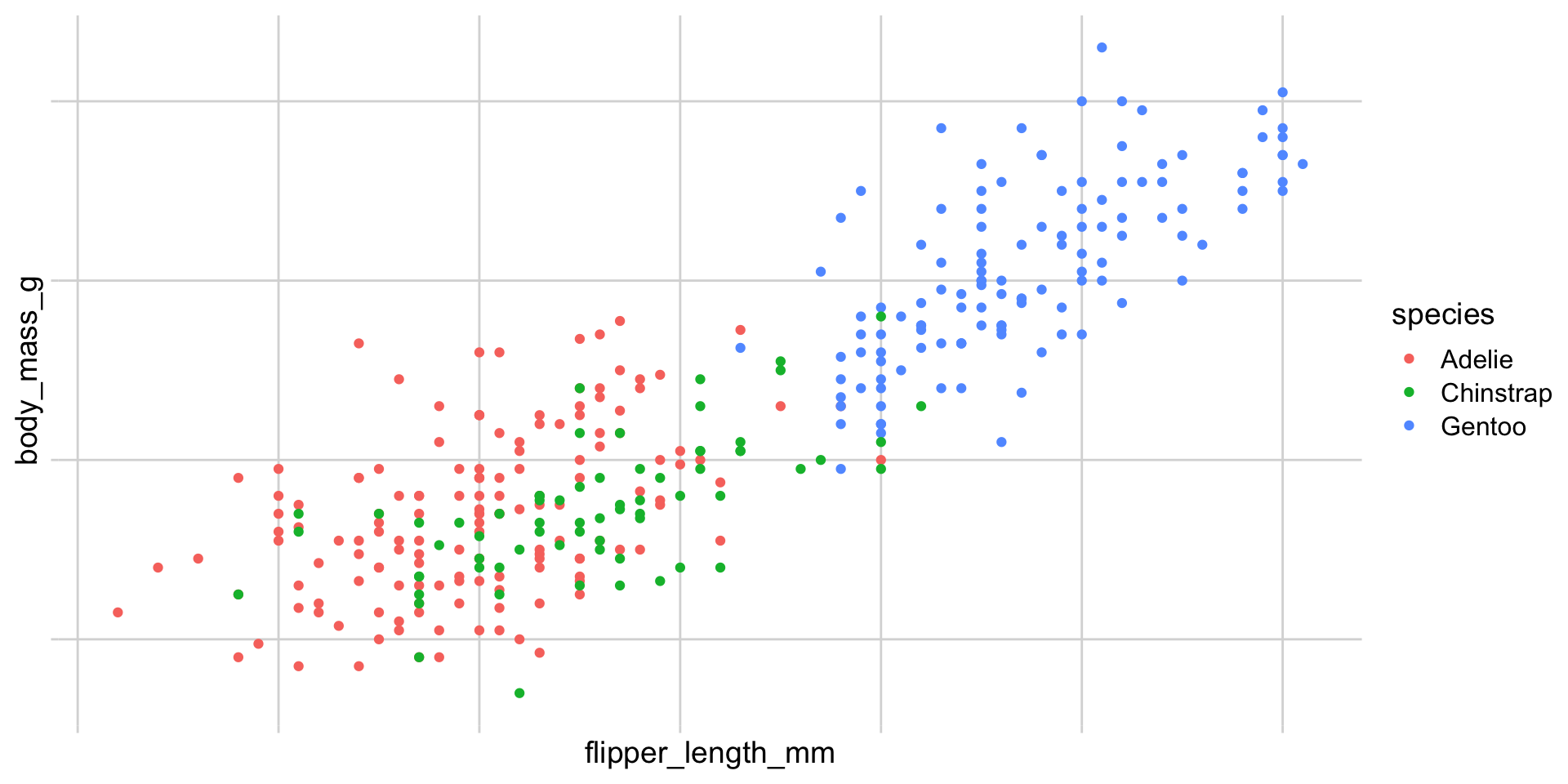
Remove elements entirely: element_blank()
ggplot(penguins) +
aes(flipper_length_mm, body_mass_g) +
geom_point(aes(color = species)) +
theme_minimal_grid() +
theme(
# no axis titles
axis.title = element_blank()
)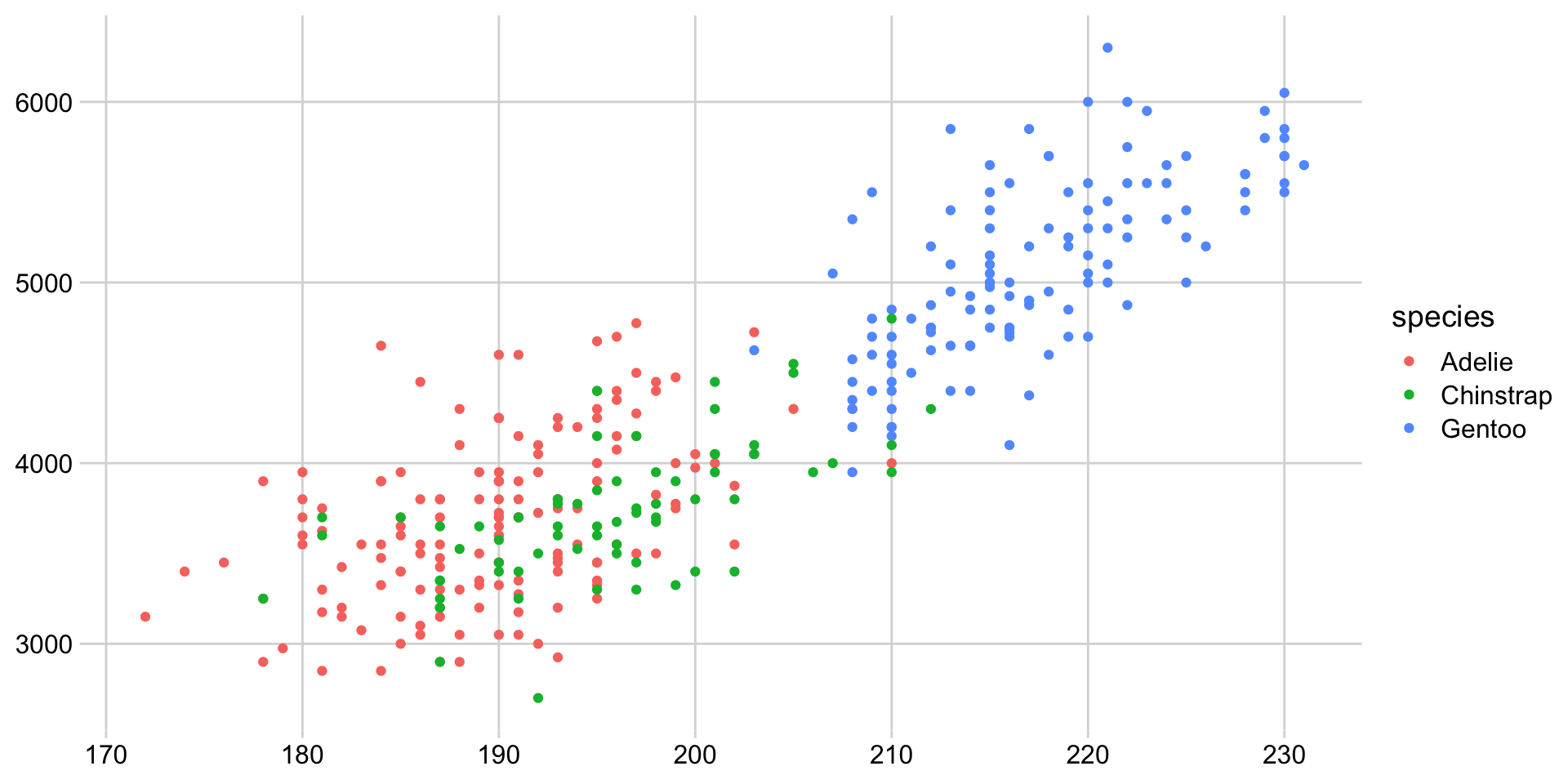
Set background color: element_rect()
ggplot(penguins) +
aes(flipper_length_mm, body_mass_g) +
geom_point(aes(color = species)) +
theme_minimal_grid() +
theme(
plot.background = element_rect(
fill = "aliceblue"
)
)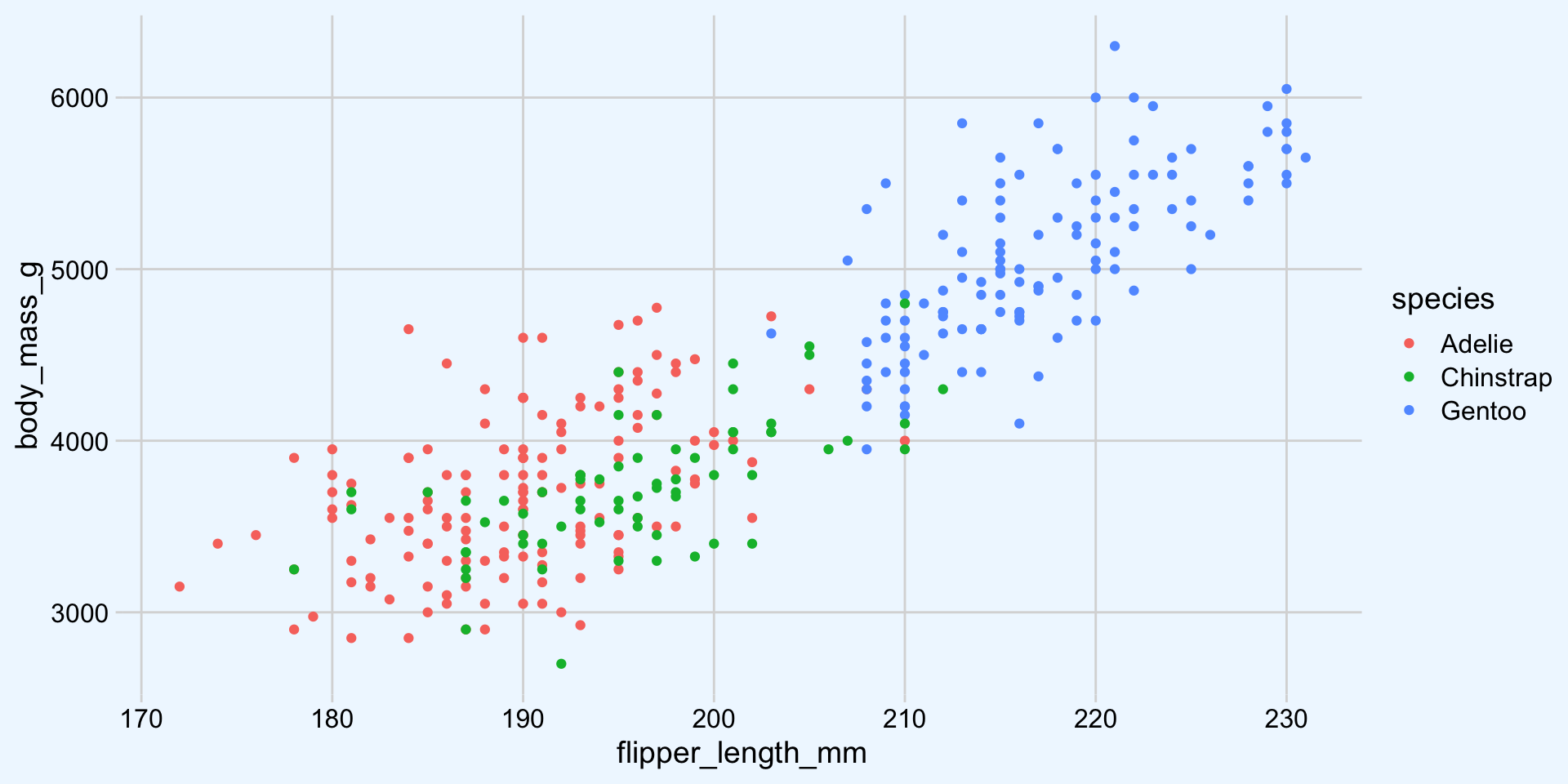
Set background color: element_rect()
ggplot(penguins) +
aes(flipper_length_mm, body_mass_g) +
geom_point(aes(color = species)) +
theme_minimal_grid() +
theme(
panel.background = element_rect(
fill = "aliceblue"
)
)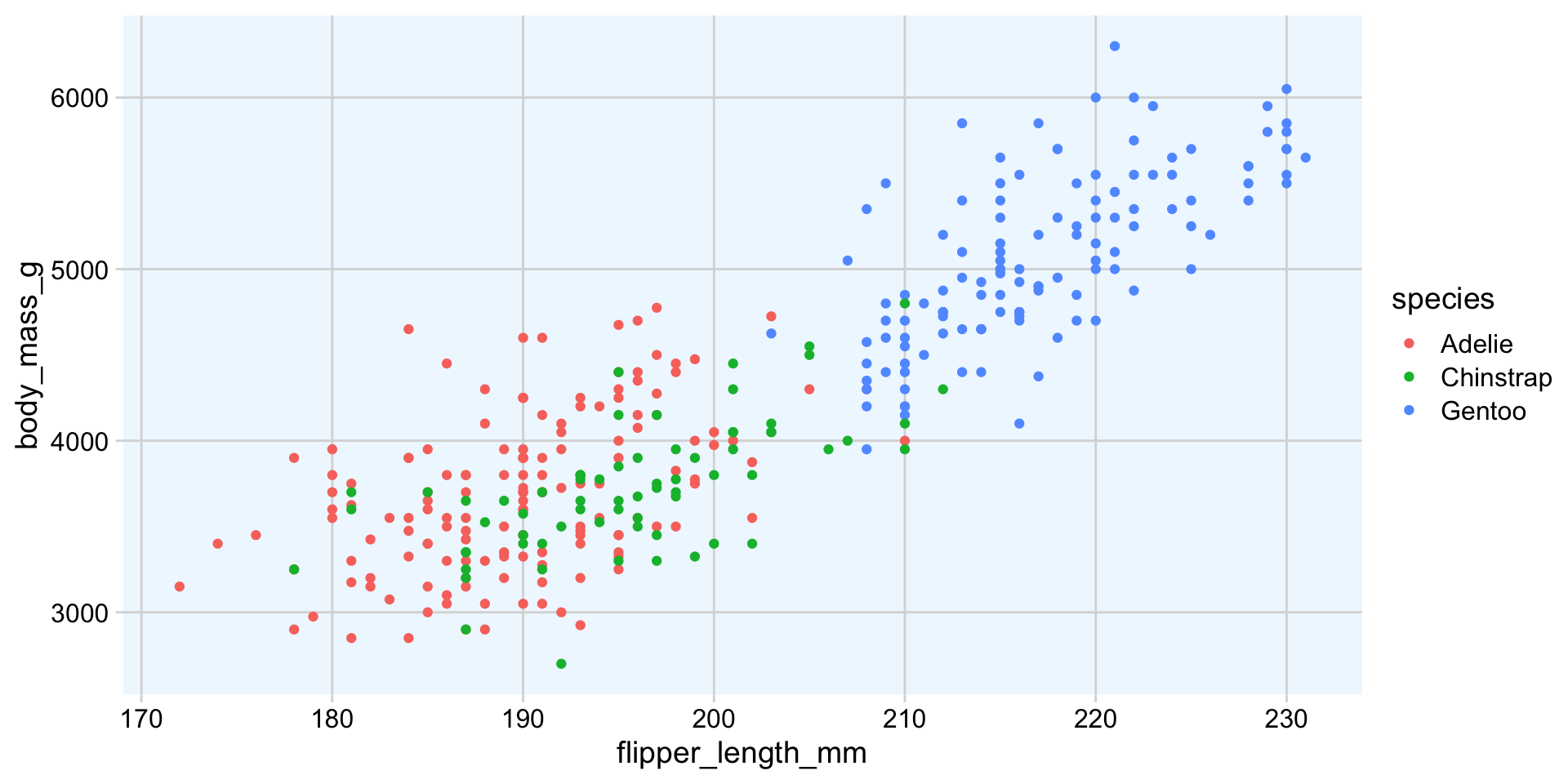
Set background color: element_rect()
ggplot(penguins) +
aes(flipper_length_mm, body_mass_g) +
geom_point(aes(color = species)) +
theme_minimal_grid() +
theme(
legend.box.background = element_rect(
fill = "aliceblue",
color = "steelblue4" # line color
)
)
Set background color: element_rect()
ggplot(penguins) +
aes(flipper_length_mm, body_mass_g) +
geom_point(aes(color = species)) +
theme_minimal_grid() +
theme(
legend.box.background = element_rect(
fill = "aliceblue",
color = "steelblue4" # line color
),
legend.box.margin = margin(7, 7, 7, 7)
)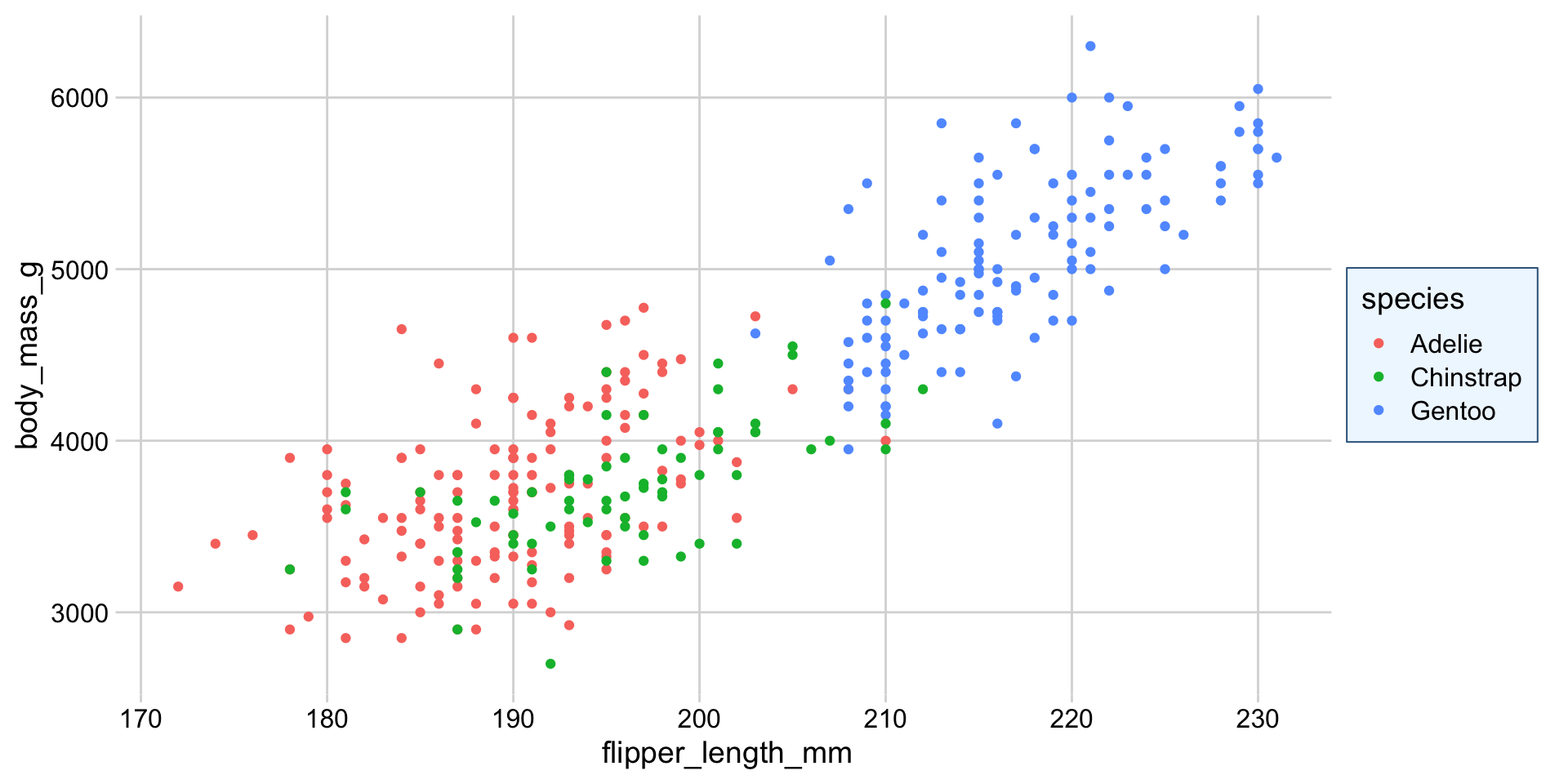
Move the legend: legend.position
ggplot(penguins) +
aes(flipper_length_mm, body_mass_g) +
geom_point(aes(color = species)) +
theme_minimal_grid() +
theme(
legend.box.background = element_rect(
fill = "aliceblue",
color = "steelblue4" # line color
),
legend.box.margin = margin(7, 7, 7, 7),
# relative position inside plot panel
legend.position = c(1, 0),
# justification relative to position
legend.justification = c(1, 0)
)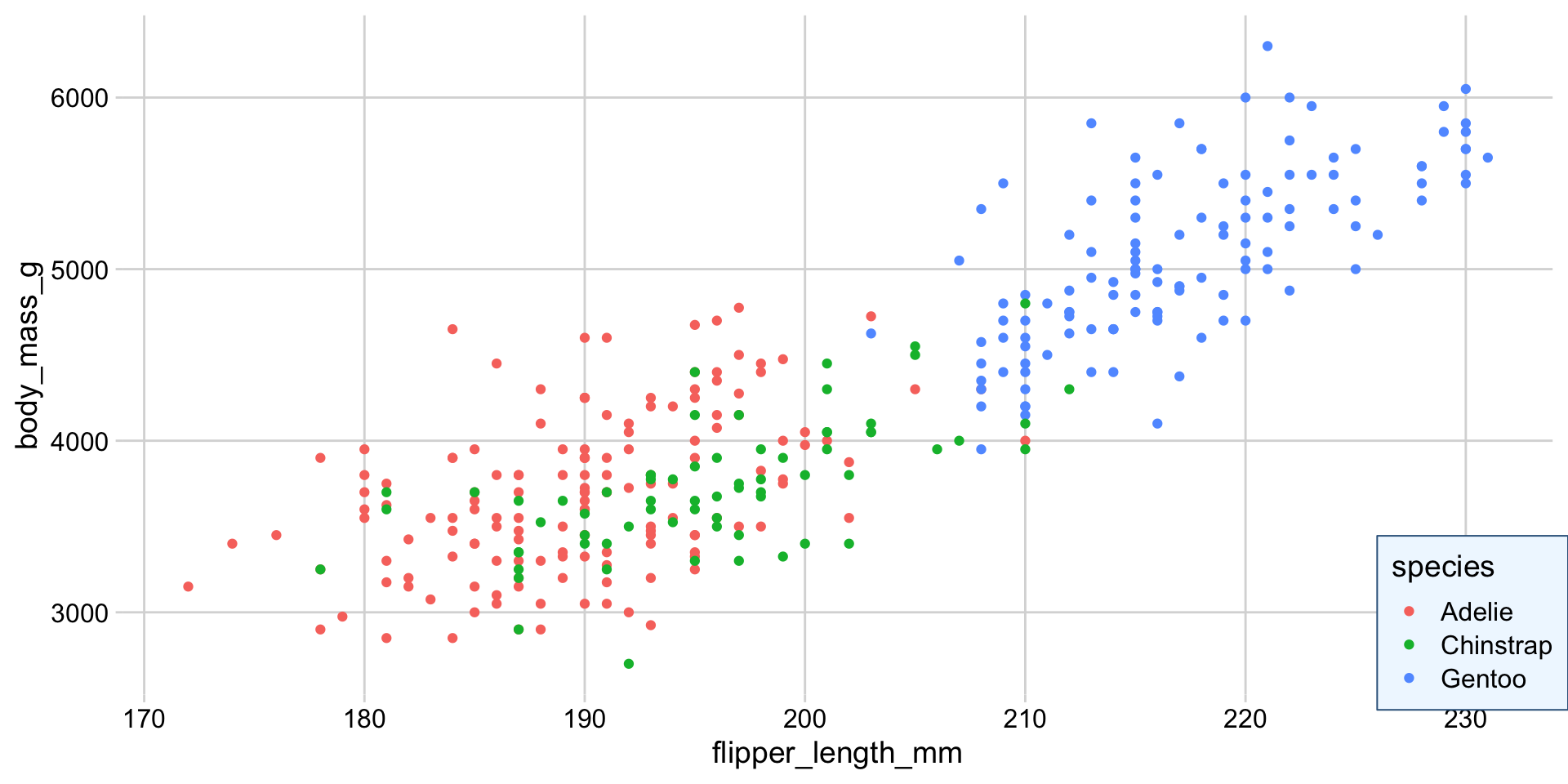
Exercise
Go to https://elsherbini.github.io/durban-data-science-for-biology/materials/1-workshop1/7-custom-data-visualizations/#coding-exercise-7.2 and complete the Compound Figures exercise.











